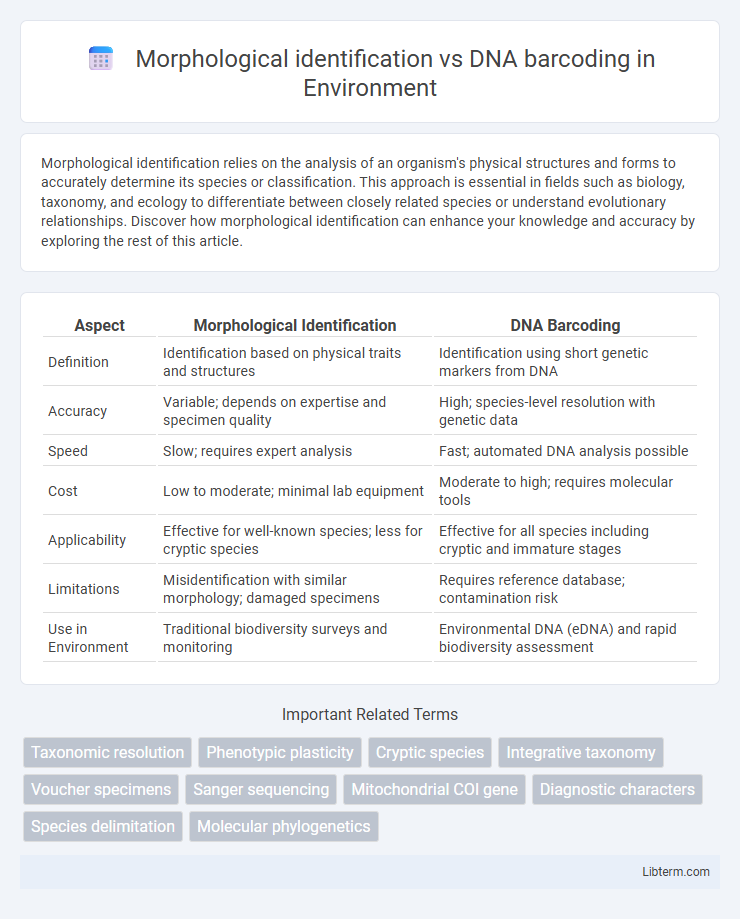Morphological identification relies on the analysis of an organism's physical structures and forms to accurately determine its species or classification. This approach is essential in fields such as biology, taxonomy, and ecology to differentiate between closely related species or understand evolutionary relationships. Discover how morphological identification can enhance your knowledge and accuracy by exploring the rest of this article.
Table of Comparison
| Aspect | Morphological Identification | DNA Barcoding |
|---|---|---|
| Definition | Identification based on physical traits and structures | Identification using short genetic markers from DNA |
| Accuracy | Variable; depends on expertise and specimen quality | High; species-level resolution with genetic data |
| Speed | Slow; requires expert analysis | Fast; automated DNA analysis possible |
| Cost | Low to moderate; minimal lab equipment | Moderate to high; requires molecular tools |
| Applicability | Effective for well-known species; less for cryptic species | Effective for all species including cryptic and immature stages |
| Limitations | Misidentification with similar morphology; damaged specimens | Requires reference database; contamination risk |
| Use in Environment | Traditional biodiversity surveys and monitoring | Environmental DNA (eDNA) and rapid biodiversity assessment |
Introduction to Species Identification Methods
Morphological identification relies on analyzing physical traits such as shape, size, color, and anatomical features to classify species, offering a traditional and accessible approach. DNA barcoding uses specific genetic markers, typically the mitochondrial COI gene, to distinguish species through molecular analysis, providing high accuracy even for cryptic or juvenile specimens. Combining morphological and DNA barcoding methods enhances species identification by integrating observable characteristics with genetic data for comprehensive biodiversity assessment.
Overview of Morphological Identification
Morphological identification relies on analyzing physical traits such as shape, size, color, and anatomical features to classify and distinguish species. This method is widely used in taxonomy due to its simplicity and cost-effectiveness, especially in field studies and biodiversity assessments. However, morphological identification can be limited by phenotypic plasticity, cryptic species, and the need for expert knowledge to accurately interpret characteristics.
Fundamentals of DNA Barcoding
Morphological identification relies on physical characteristics such as shape, size, and color patterns to classify organisms, which can be limited by phenotypic plasticity and developmental stages. DNA barcoding uses a standardized region of mitochondrial DNA, commonly the cytochrome c oxidase I (COI) gene, to provide precise and rapid species identification by comparing sequences against a reference database. This molecular approach bypasses ambiguities in morphology, enabling accurate differentiation even among cryptic or juvenile species.
Historical Context and Evolution of Identification Techniques
Morphological identification, rooted in Linnaean taxonomy since the 18th century, relied on observable traits such as shape, size, and structure to classify organisms, forming the foundation of traditional biological classification. DNA barcoding emerged in the early 2000s as a molecular technique using short, standardized gene regions--such as the mitochondrial COI gene in animals--to provide precise species identification and resolve ambiguities associated with morphological similarities and cryptic species. The evolution from morphology-based methods to molecular barcoding reflects advances in genetics and bioinformatics, enabling faster, more accurate biodiversity assessments and expanding taxonomic resolution beyond classical morphology limitations.
Strengths of Morphological Identification
Morphological identification excels in providing immediate, cost-effective species recognition through observable physical traits, making it accessible for field research without specialized equipment. It allows for the detection of phenotypic variations and developmental stages that DNA barcoding may overlook, contributing valuable ecological and behavioral context. This method supports rapid biodiversity assessments and classical taxonomy, reinforcing foundational biological knowledge essential for conservation efforts.
Advantages of DNA Barcoding
DNA barcoding offers higher accuracy in species identification compared to morphological methods, especially for cryptic or morphologically similar species. It enables rapid and reliable identification from small or degraded samples, increasing efficiency in biodiversity assessments. The technique also facilitates the creation of standardized, globally accessible reference libraries, enhancing consistency and comparability across studies.
Limitations and Challenges of Each Approach
Morphological identification faces limitations such as phenotypic plasticity, cryptic species, and reliance on expert taxonomists, which can lead to misidentification or incomplete species resolution. DNA barcoding challenges include incomplete reference databases, potential contamination, and difficulties in amplifying DNA from degraded samples, which can reduce accuracy and reliability. Both methods require integration to overcome their respective constraints and improve species identification and biodiversity assessments.
Case Studies: Morphology vs DNA Barcoding
Case studies comparing morphological identification and DNA barcoding reveal significant discrepancies in species recognition, particularly in cryptic or morphologically similar taxa. DNA barcoding demonstrates higher accuracy and consistency by analyzing mitochondrial COI gene sequences, enabling precise identification where morphological traits are ambiguous or phenotypically plastic. Morphology-based methods remain valuable for rapid assessments, but integrating DNA barcoding enhances taxonomic resolution and biodiversity monitoring, especially in ecological and conservation research.
Integrative Approaches: Combining Methods for Accuracy
Integrative approaches in species identification combine morphological identification and DNA barcoding to enhance accuracy and reliability. Morphological methods analyze physical traits, while DNA barcoding uses standardized genetic markers such as the COI gene to differentiate species at the molecular level. Combining these techniques resolves ambiguities caused by phenotypic plasticity or cryptic species, providing comprehensive taxonomic resolution in biodiversity studies.
Future Trends in Species Identification
Future trends in species identification emphasize the integration of morphological identification with DNA barcoding to enhance accuracy and efficiency. Advances in high-throughput sequencing technologies and machine learning algorithms are facilitating rapid, cost-effective species identification across diverse taxa. Combining traditional morphological traits with genomic data improves species discovery, biodiversity monitoring, and conservation efforts.
Morphological identification Infographic

 libterm.com
libterm.com